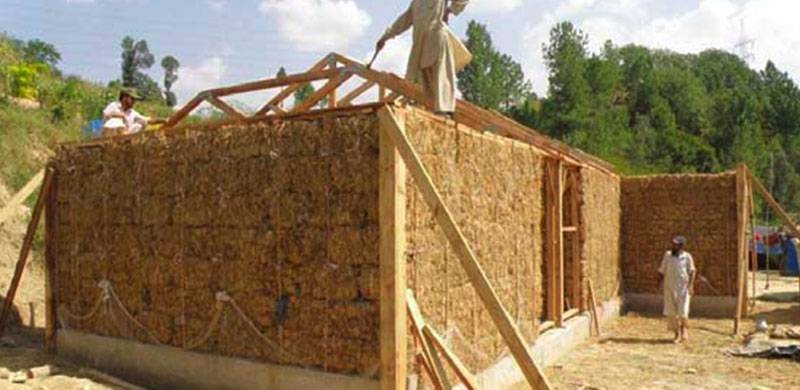
For a population of 224 million people in Pakistan, perhaps the most daunting need is housing.
Pakistan needs to build 350,000 units per year; however, its current building capacity is 150,000 units which is 58 percent less than the requirements. The previous government initiated a housing scheme which is now stalled due to unsound economic challenges in the country. It is unlikely to continue further.
The buildings constructed in Pakistan are generally not green. They emit more carbon and pollute the air. The Sustainable Development Goals (SDGs) set sustainable housing (green housing) as one of the goals. They bind the nations to use modern techniques of construction and discourage steel and cement to prevent carbon emissions. For instance, heating, cooling and powering houses and offices contribute to 27 percent of carbon emissions. According to The Economist, 13,000 buildings will be needed per day by 2050 to counter the global population growth.
However, Pakistan has a dirty construction industry that has little chance of going green. The environment protection departments are good for nothing. Consequently, an unbalanced environment is causing global warming and climate change which are not only affecting lives but also crops. For example, as per the government sources, mango production has declined by almost 50 percent this year, and it is expected that the other crops will also be affected in the same way.
How can the construction industry be made green? First, the policymakers should provide environment friendly housing to the underprivileged – using modern construction techniques, green roofs, and gardens. Second, the policymakers must prioritise more energy-efficient buildings and renewable energy sources. They must encourage renovation of buildings rather than demolishing old ones that create fumes and dust and make the air dirty.
Apart from this, they must impose a carbon tax to help reduce emission of carbon. It is an approved and practical way prescribed by the UN. FDI can also be invited from wealthy countries to invest in clean infrastructure and buildings so that locals will have modern and green architecture.
Switching to sustainable cities and towns can be costly but the future generations can be saved from the disastrous effects of climate change. If planned steps, like going green, reducing carbon emissions, promoting planting, and modern ways of building houses and infrastructure are taken, the day is not far when houses in the country will be clean and green.
Pakistan needs to build 350,000 units per year; however, its current building capacity is 150,000 units which is 58 percent less than the requirements. The previous government initiated a housing scheme which is now stalled due to unsound economic challenges in the country. It is unlikely to continue further.
The buildings constructed in Pakistan are generally not green. They emit more carbon and pollute the air. The Sustainable Development Goals (SDGs) set sustainable housing (green housing) as one of the goals. They bind the nations to use modern techniques of construction and discourage steel and cement to prevent carbon emissions. For instance, heating, cooling and powering houses and offices contribute to 27 percent of carbon emissions. According to The Economist, 13,000 buildings will be needed per day by 2050 to counter the global population growth.
However, Pakistan has a dirty construction industry that has little chance of going green. The environment protection departments are good for nothing. Consequently, an unbalanced environment is causing global warming and climate change which are not only affecting lives but also crops. For example, as per the government sources, mango production has declined by almost 50 percent this year, and it is expected that the other crops will also be affected in the same way.
The policymakers must prioritise more energy-efficient buildings and renewable energy sources. They must encourage renovation of buildings rather than demolishing old ones that create fumes and dust and make the air dirty.
How can the construction industry be made green? First, the policymakers should provide environment friendly housing to the underprivileged – using modern construction techniques, green roofs, and gardens. Second, the policymakers must prioritise more energy-efficient buildings and renewable energy sources. They must encourage renovation of buildings rather than demolishing old ones that create fumes and dust and make the air dirty.
Apart from this, they must impose a carbon tax to help reduce emission of carbon. It is an approved and practical way prescribed by the UN. FDI can also be invited from wealthy countries to invest in clean infrastructure and buildings so that locals will have modern and green architecture.
Switching to sustainable cities and towns can be costly but the future generations can be saved from the disastrous effects of climate change. If planned steps, like going green, reducing carbon emissions, promoting planting, and modern ways of building houses and infrastructure are taken, the day is not far when houses in the country will be clean and green.

